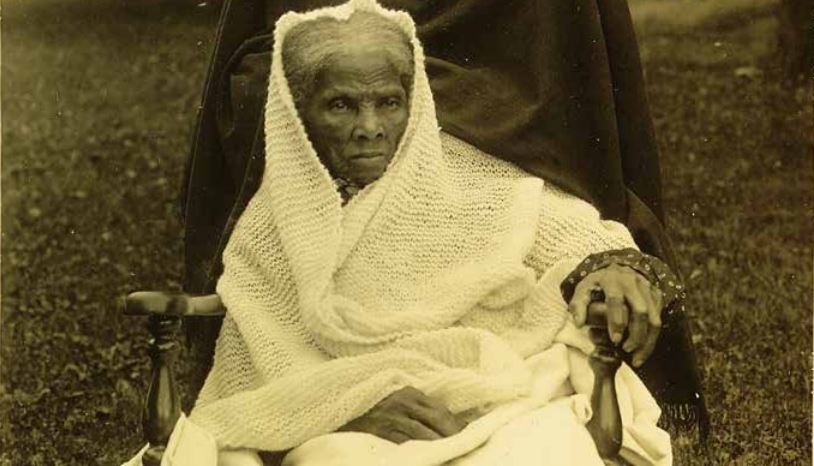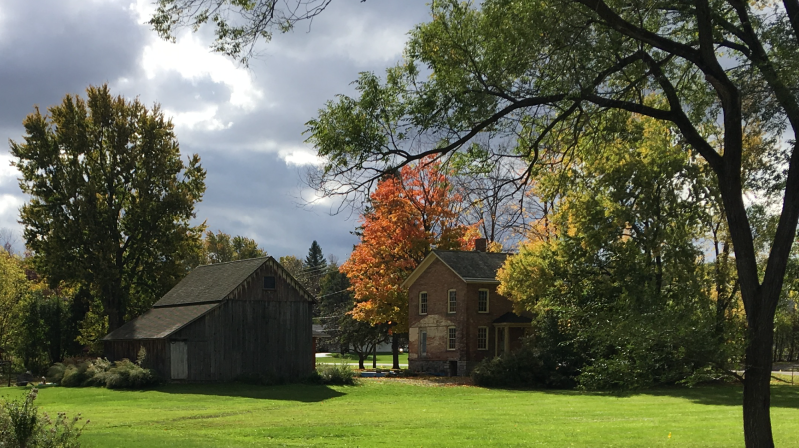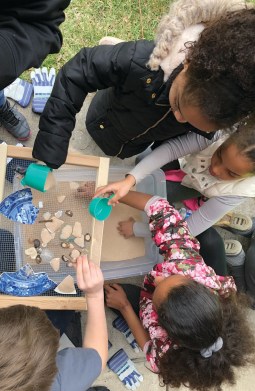
In commemoration of the 100th anniversary of the passage of the 19th Amendment that gave women the right to vote, we pay tribute to a luminous spirit that enlightens our quest for human rights and dignity.
This article originally appeared in the March/April 2020 issue of Museum magazine, a benefit of AAM membership.
Harriet Tubman looms large on America’s historical landscape. At a time when academic scholarship and digitally accessible records have revealed the tarnished characters and actions of many a historic figure, Tubman’s extraordinary reputation has only grown. Scholars such as Kate Clifford Larson have shed light on lesser-known aspects of Tubman’s life, and the 2019 biopic Harriet underscored the dangerous work she undertook to secure freedom for African Americans.
Tubman has two national parks named after her, an honor only two other historic figures (Abraham Lincoln and Theodore Roosevelt) can claim. The Harriet Tubman Underground Railroad National Historical Park (formerly the Harriet Tubman Underground Railroad National Monument) was established as a partnership with the state of Maryland in Dorchester County in 2014. And the Harriet Tubman National Historical Park was established as a partnership with Harriet Tubman Home, Inc., in Auburn, New York, in 2017.
Tubman is widely known as a central figure in the Underground Railroad, which helped enslaved African Americans escape to freedom, but she was also a committed women’s suffragist and social activist who focused on education and caring for the elderly. She never stopped fighting for human rights for all.
Becoming Harriet Tubman
Many Americans are familiar with the powerful story of Tubman’s early life told at the Maryland site, which stands on 480 acres of land where Tubman lived enslaved, and eventually escaped, returning repeatedly to rescue dozens of other enslaved African Americans.
Born Araminta Ross around 1822, she suffered a severe blow to her head as a young girl when an overseer struck her with a metal weight purportedly aimed at an enslaved person attempting to escape. Though she recovered, the injury led to seizures, violent headaches, and blackouts throughout her life. During her blackouts, Araminta would experience vivid visions and dreams, which she attributed to God speaking directly to her, reinforcing her already strong spiritual beliefs.
Araminta, or “Minty” as she was known to her family, took the name Harriet Tubman sometime after she married a free black man named John Tubman in 1844. Under threat of being sold and permanently separated from her family when plantation owner Edward Brodess died in 1849, Tubman decided to seek her freedom in the North.
She successfully escaped to Philadelphia, but she was determined to return to Maryland to bring her family members to freedom with her. Over the next 10 years, she served as a conductor on the Underground Railroad, orchestrating the emancipation of more than 70 enslaved African Americans. Her feats catapulted her into the national spotlight and brought her into contact with famous abolitionists like Frederick Douglass, who noted years later in a letter to her that “Excepting John Brown—of sacred memory—I know of no one who has willingly encountered more perils and hardships to serve our enslaved people than you have.”
For many people, this is where Tubman’s incredible story ends. However, this was only the first half of her life. The national park in Auburn, New York, offers a glimpse into Tubman’s post-Civil War life and her pioneering work as a humanitarian and suffragist, aspects of her life that have only recently surfaced in the popular public consciousness.
Working for Social Justice
Known today for its wine and lakeside recreational opportunities, the Finger Lakes region of New York in the early to mid-19th century was a hotbed of religious fomentation and civil rights activism. The Second Great Awakening that swept the area in the early 1800s led famed minister Charles Grandison Finney to refer to it as a “burnt district” of fiery religious revivalism. Some of this zeal was channeled into reform movements, including abolition and women’s rights. The First Woman’s Rights Convention took place in Seneca Falls, just 15 miles down the road from Auburn, in 1848.

Into this environment came Tubman, who by the late 1850s was seeking a more comfortable place to live for her aging parents and other freedom seekers she had brought to Canada. It may have been Auburn resident Martha Coffin Wright, one of the five organizers of the First Woman’s Rights Convention, who introduced Tubman to William Seward, the US senator from New York at the time. In 1859, Seward sold Tubman a seven-acre property in Fleming, New York, including a house and barn, for the fair market price of $1,200. Following her work as a scout, spy, and nurse during the Civil War, it is here Tubman would care for her parents and other family members and begin the second chapter of her life as a champion for social justice.
Recognizing the poverty that many free African Americans found themselves in after the Civil War, Tubman raised money for the Freedmen’s Bureau to support its work in the South teaching freed blacks to read and write. Tubman used proceeds from an early biography about herself to care for those in need within Auburn’s black community. When necessary, she opened her own home to care for those too ill or indigent to care for themselves. Though she had very little herself, she never hesitated to offer assistance to those in need.
Tubman’s faith was central to her life; to that end, she pledged $500 of her own money toward the building of the Thompson Memorial African Methodist Episcopal Zion Church on Parker Street, which she would attend for 30 years. The site is currently undergoing rehabilitation and in the future will be open to the public as part of the Harriet Tubman National Historical Park.
In later years, Tubman focused on helping elderly African Americans, who were more vulnerable to poverty. She raised money to create a home for the elderly and poor, carrying on the work that she said: “the Lord meant me to do.”
In 1896, she purchased 25 acres of land in Auburn, New York, adjacent to her property, and began raising the monies needed to convert one of the two homes on the property into a home for the aged. Unable to attain the necessary funds and advancing in age—by 1903 she was into her 80s—she deeded the property to the AME Zion Church, which opened the Tubman Home for Aged and Infirm Negroes in 1908.
Tubman spent the last two years of her life in John Brown Hall, the original location of the Tubman Home for Aged and Infirm Negroes. Her mind remained sharp, but her body had failed her. Visitors to Harriet Tubman National Historical Park can now tour the second location of the Tubman Home for Aged and Infirm Negroes, walk her farmland, and see her residence.
Fighting for the Right to Vote
Tubman’s commitment to social justice also manifested itself through her involvement in the women’s suffrage movement. A symbol of female empowerment, Tubman joined her friends Elizabeth Cady Stanton and Susan B. Anthony in the campaign for women’s right to vote.
She was an honorary lifetime member in the Geneva (New York) Political Equality Club, whose members included Rhoda Palmer, an attendee at the First Woman’s Rights Convention who lived to see women vote in New York state in 1917, and Elizabeth Smith Miller, a dress reform advocate and cousin of Elizabeth Cady Stanton.
In 1896, Tubman was invited to speak before a meeting of the newly formed National Association of Colored Women, an organization that advocated for African American rights and women’s right to vote. She spoke of her work on the Underground Railroad and in the Civil War and ended by stressing the need to care for the elderly.
At 91 years old, Harriet Tubman passed away on March 10, 1913. Her burial service was held in the Thompson Memorial African Methodist Episcopal Zion Church, and she was laid to rest in Auburn’s Fort Hill Cemetery. Harriet Tubman National Historical Park commemorates Tubman and her life’s work on the land where she

spent more than 50 years in freedom, at her church where she worshiped for 30 years, and in the community, she helped mold that continues to honor her legacy.
Experiencing Her Life
The Harriet Tubman National Historical Park in Auburn, New York, was established in 2017 as the 51st national historical park. The park was created in partnership with the nonprofit Harriet Tubman Home, Inc., which operates the Harriet Tubman Visitor Center, the Tubman Home for the Aged, and the Harriet Tubman Residence, all located together. Harriet Tubman Home, Inc., has stewarded the site since the 1950s.
The Visitor Center includes a timeline of Tubman’s life, and tours of Tubman’s restored Home for the Aged are offered Tuesday through Saturday. Additionally, sites throughout the city of Auburn explore Tubman’s life and legacy, including the Equal Rights Heritage Center, which features a statue of Tubman; the Seward House Museum, where visitors can learn about the connections between Tubman and William H. Seward, who was a US senator, New York governor, and secretary of state; and Tubman’s gravesite at Fort Hill Cemetery, where she was laid to rest with military honors.
The National Park Service (NPS) also operates the grounds of the Thompson Memorial AME Zion Church. In the coming years, NPS will stabilize and rehabilitate the church building, which currently can only be viewed from the outside.
For more information, visit harriettubmanhome.com and nps.gov/hart.
Andrea DeKoter, Ph.D., is acting superintendent of the Women’s Rights National Historical Park in Auburn, New York, and Harriet Tubman National Historical Park in Seneca Falls, New York. Kimberly Szewczyk is a senior interpretive specialist who manages outreach programs and community partnerships at Harriet Tubman National Historical Park.







